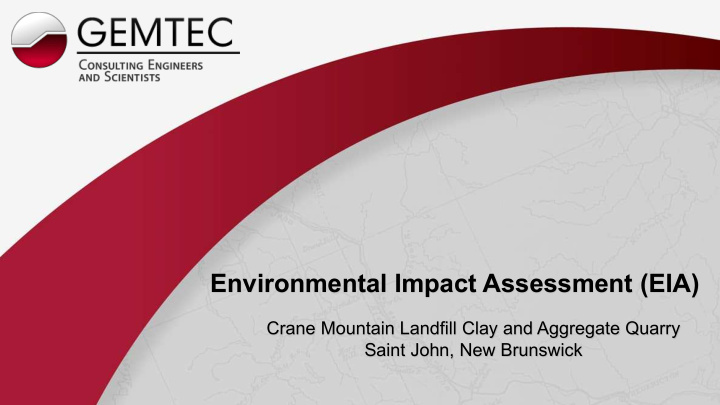



Environmental Impact Assessment (EIA) Crane Mountain Landfill Clay and Aggregate Quarry Saint John, New Brunswick
EIA – Crane Mountain Clay and Aggregate Quarry Rationale / Need for the Undertaking; Engineering Assessment; Environmental Impact Assessment (EIA) Overview; EIA – Valued Environmental Components; Timeline + Next Steps; and Questions.
Need / Rationale For the Undertaking Secure and viable source of clayey material (liner) and aggregate (rock) until end of projected landfill life; Nine landfill cells scheduled to be LANDFILL built between 2020 and 2048; Reduction of sourcing uncertainty; Reduction in construction costs; and Advantages of a clay liner.
Site Location Plan
Engineering Assessments Potential clay source on this property was known historically; In Summer 2018, the potential clay source was assessed for: o Quality (properties such as hydraulic conductivity, % clay, % moisture, plasticity, etc .); o All lab tests show the material meets or exceeds required properties; o Quantity - sufficient amount to complete all liners for the projected landfill life; Bedrock on the site was also assessed (quality and quantity); o Bedrock can be processed and used for many materials in landfill construction: i.e., gas venting layer, berm material, sub-base, road materials, etc .; and o Readily available on the site via existing access road and quarry faces.
Environmental Impact Assessment (EIA) Overview Regulatory Requirements The proposed project is specified as an undertaking outlined in Schedule A of the New Brunswick Environmental Impact Assessment Regulation 87-83 under paragraph: (v): all enterprises, activities, projects, structure, works or programs affecting two hectares of more of bog, marsh, swamp or other wetland.
Environmental Impact Assessment (EIA) Overview EIA Methodology 1. Valued Environmental Components (VEC); 2. Boundaries + Methodology; 3. Existing Environment; 4. Potential Project Effects; 5. Mitigation Measures; and 6. Significant Residual Effects.
EIA – Valued Environmental Components (VEC) Atmospheric Environment; Groundwater; Aquatic Environment; Wildlife and Wildlife Habitat; Wetlands and Vegetation; Archeological and Heritage Areas; Land Use; and Effects of the Environment on the Project.
Next Steps + Timeline Work Component Month of Completion DRAFT EIA Report for FRSC Review December, 2018 Submission of EIA Report to NBDELG (EIA Registration) December, 2018 or January, 2019 Public Involvement January - July, 2019 GEMTEC Receipt of Technical Review Committee (TRC) March, 2019 GEMTEC Response to TRC Questions April, 2019 Required Additional Assessments (Rare Plant, Breeding Bird, Archeological) May - June, 2019 Round 2 TRC Review July, 2019 GEMTEC Response to TRC Questions September, 2019 Final Determination November, 2019
QUESTIONS? Marco Sivitilli, P.Eng. Jennifer Hachey, B.Sc.
Recommend
More recommend